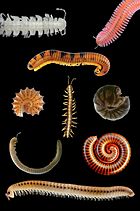Archipolypoda
| Archipolypoda Temporal range:
| |
|---|---|

| |
| Reconstruction of Acantherpestes major | |
| Scientific classification | |
| Domain: | Eukaryota |
| Kingdom: | Animalia |
| Phylum: | Arthropoda |
| Subphylum: | Myriapoda |
| Class: | Diplopoda |
| Subclass: | Chilognatha |
| Superorder: | †Archipolypoda Scudder, 1882 |
| Orders | |
| Synonyms | |
|
Macrosterni Fritsch, 1899 | |

Archipolypoda is an extinct group of millipedes known from fossils in Europe and North America and containing the earliest known land animals.[1] The Archipolypoda was erected by Scudder (1882)[2] but redefined in 2005 with the description of several new species from Scotland.[3] Distinguishing characteristics include relatively large eyes with densely packed ocelli (sometimes interpreted as compound eyes), and modified leg pairs on the 8th body ring.[3][4] Some species had prominent spines while others had a flattened appearance.[3][5]
Classification
The Archipolypoda as currently recognized consists of four orders,[6] many with monotypic families and genera, as well as five species of uncertain placement (incertae sedis).[3][7]
Archidesmida Wilson & Anderson, 2004
- Archidesmidae Scudder, 1885
- Archidesmus macnicoli Peach, 1882. Lower Devonian, Scotland
- Zanclodesmidae Wilson, Daeschler & Desbiens, 2005
- Zanclodesmus willetti Wilson, Daeschler & Desbiens, 2005. Upper Devonian, Quebec, Canada
- Orsadesmus rubecollus Wilson, Daeschler & Desbiens, 2005. Upper Devonian, Pennsylvania, USA
Cowiedesmida Wilson & Anderson, 2004
- Cowiedesmidae Wilson & Anderson, 2004
- Cowiedesmus eroticopodus Wilson & Anderson, 2004. Mid Silurian or Lower Devonian,[8] Scotland.
Euphoberiida Hoffman, 1969
- Euphoberiidae Scudder, 1882. Upper Carboniferous of Europe and North America.
- Acantherpestes Meek & Worthen, 1868
- Euphoberia Meek & Worthen, 1868
- Myriacantherpestes Burke, 1979
Palaeosomatida Hannibal & Krzeminski, 2005. Carboniferous, UK and Poland[9]
- Palaeosomatidae Hannibal & Krzeminski, 2005
Order incertae sedis
- Albadesmus almondi Wilson & Anderson, 2004 Mid Silurian or Lower Devonian,[8] Scotland
- Anaxeodesmus diambonotus Wilson, 2005 Upper Carboniferous, UK.
- Anthracodesmus macconochiei, Peach, 1899
- Palaeodesmus tuberculata (Brade-Birks, 1923) (=Kampecaris tuberculata) Lower Devonian, Scotland.
- Pneumodesmus newmani Wilson & Anderson, 2004 Mid Silurian or Lower Devonian,[8] Scotland
See also
- Arthropleuridea- Another group of extinct millipedes
- Euthycarcinoidea, a group of enigmatic arthropods that may be ancestral to myriapods
- Colonization of land, major evolutionary stages leading to terrestrial organisms
References
- ^ Selden, Paul; Helen Read (2008). "The Oldest Land Animals: Silurian Millipedes from Scotland" (PDF). Bulletin of the British Myriapod & Isopod Group. 23: 36–37.
- ^ Scudder, Samuel H. (1882). "Archipolypoda, a Subordinal Type of Spined Myriapods from the Carboniferous Formation". Memoirs of the Boston Society of Natural History. 3 (5): 143.
- ^ a b c d Wilson, Heather M.; Anderson, Lyall I. (2004). "Morphology and taxonomy of Paleozoic millipedes (Diplopoda: Chilognatha: Archipolypoda) from Scotland". Journal of Paleontology. 78 (1): 169–184. doi:10.1666/0022-3360(2004)078<0169:MATOPM>2.0.CO;2. JSTOR 4094847. S2CID 131201588.
- ^ Sierwald, Petra; Bond, Jason E. (2007). "Current Status of the Myriapod Class Diplopoda (Millipedes): Taxonomic Diversity and Phylogeny". Annual Review of Entomology. 52 (1): 401–420. doi:10.1146/annurev.ento.52.111805.090210. PMID 17163800.
- ^ Wilson, Heather M.; Daeschler, Edward B.; Desbiens, Sylvain (2005). "New Flat-Backed Archipolypodan Millipedes from the Upper Devonian of North America". Journal of Paleontology. 79 (4): 738–744. doi:10.1666/0022-3360(2005)079[0738:NFAMFT]2.0.CO;2. JSTOR 4095046. S2CID 140190612.
- ^ Shear, William A.; Edgecombe, Gregory D. (2010). "The geological record and phylogeny of the Myriapoda". Arthropod Structure & Development. 39 (2–3): 174–190. doi:10.1016/j.asd.2009.11.002. PMID 19944188.
- ^ Wilson, Heather M. (2005). "A new genus of Archipolypodan millipede from the Coseley Lagerstatte, Upper Carboniferous, UK". Palaeontology. 48 (5): 1097–1100. Bibcode:2005Palgy..48.1097W. doi:10.1111/j.1475-4983.2005.00496.x.
- ^ a b c Suarez, Stephanie E.; Brookfield, Michael E.; Catlos, Elizabeth J.; Stöckli, Daniel F. (2017-06-28). "A U-Pb zircon age constraint on the oldest-recorded air-breathing land animal". PLOS ONE. 12 (6): e0179262. Bibcode:2017PLoSO..1279262S. doi:10.1371/journal.pone.0179262. ISSN 1932-6203. PMC 5489152. PMID 28658320.
- ^ Hannibal, Joseph T.; Krzeminski, Wieslaw (2005). "A palaeosomatid millipede (Archipolypoda: palaeosomatida) from the Carboniferous (Namurian A) of Silesia, Poland". Polskie Pismo Entomologiczne. 74 (3): 205–217.



